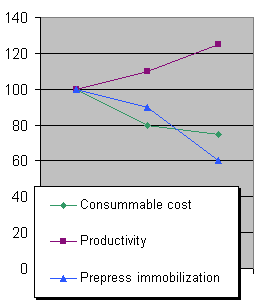Your
returns on investment
|

|
Color
Quality and productivity:
You
can reproduce well only what you can measure: Only controlling color
reproduction by methods based upon measure can allow optimal use of all
market's hardware and software, whether they are "proprietary"
or "open", and whether their design is good or not.
Your gains of productivity can usually reach 30 %!
Savings consumable:
In addition to saving time, very important savings in
ink and media can be achieved.
Choosing
the best production tools and processes:
Investing today in proprietary calibrated
monitors, proprietary proofing systems, and much other expensive prepress
equipment is no longer necessary for Users who are properly trained to digital
color.
You cannot choose your professional work tools without having the least idea of their working principles and critical points to be
examined. In
addition, best tools are seldom the most expensive ones!
|
Some
frequently found consequences of insufficient training to Digital
Color:
|
|
Misuse
of the existing production equipments:
|
Badly
parameterized software and drivers.
|
|
Choice
of new tools having a very bad performance/ price ratio:
|
Purchase
of expensive and nonproductive color proofing systems. Purchase of
equipments unable to take advantage and benefits from I.C.C. Belief that
if a product is very expensive and from a well-known Brand, it should be
good.
|
|
Choice
of non-working tools:
|
Purchase
of scanners, digital cameras, and printers not being able to use
correctly I.C.C. profiles, contrarily to their Vendors advertisements.
|
|
Choice
of new tools unsuited to the needs:
|
Use
of ink-jet printers for volume color proofing in publishing industries.
Use of proprietary calibrated RGB monitors. Use of unnecessarily
expensive scanners.
|
|
Choice
of new tools not meeting the technical specifications advertised by
their Vendor:
|
Purchase
of scanners or video projectors not meeting the technical specifications
of resolution or power praised by their Vendors. Purchase of printers
having a much higher cost by copy than advertised.
|
|
Technical
reception of non-working products:
|
Satisfaction
by new equipments working better, but not working correctly!
|
|
Waste
of consumable:
|
Production
of useless paper proofs, bad choice of printers, bad color separations.
Waste at press settings.
|
|
Waste
of time:
|
Work
rather based on experience and black art than on understanding and
methods.
|
|
Incapacity
to develop a real Customer's partnership:
|
Incapacity
to draw up a clear quality contract with the Customer. Non justified
final improvements for free. Too random technical quality and
delays. Incapacity to prove to the Customer his request is physically
impossible to satisfy. Incapacity to prove to the Customer your work
is good.
|
|
Incapacity
to defend
your own interests:
|
Incapacity
to control the upstream or downstream work quality of the other
subcontractors in the event of a final quality problem and conflict, by
default of a sufficient knowledge of each Trade of the graphic chain.
|
|
Bad
design of new products:
|
Manufacturers
whose products are unaware of customer's Trade and their expressed or
non-expressed requirements. Products designed by data processing
specialists ignoring color measurement. Choice of bad technical
specifications. Unnecessarily complex and expensive drivers. Bad
Man-Machine interface. Developers working for themselves and not for the
Customers.
|
|
Incapacity
to sell good products:
|
Products
Marketed or installed without knowledge of Customer's Trade and color
measurement. Unsuited marketing to Graphic Arts.
|
|
Choice
of non-competitive contractors:
|
Work
with subcontractors drowned by modern technology, having acquired to
reassure themselves out of market prices and nonproductive
proprietary equipments, of which they will of course tell you the
qualities.
|
|
Bad
strategic vision of market evolution:
|
Incapacity
to distinguish true innovations from media background noise. Useless
replacement of processors, hardware, and software. Accepting bad purchase
conditions masking the real costs. Bad priorities in the investments.
Ignorance of real costs and market trends.
|
|
|